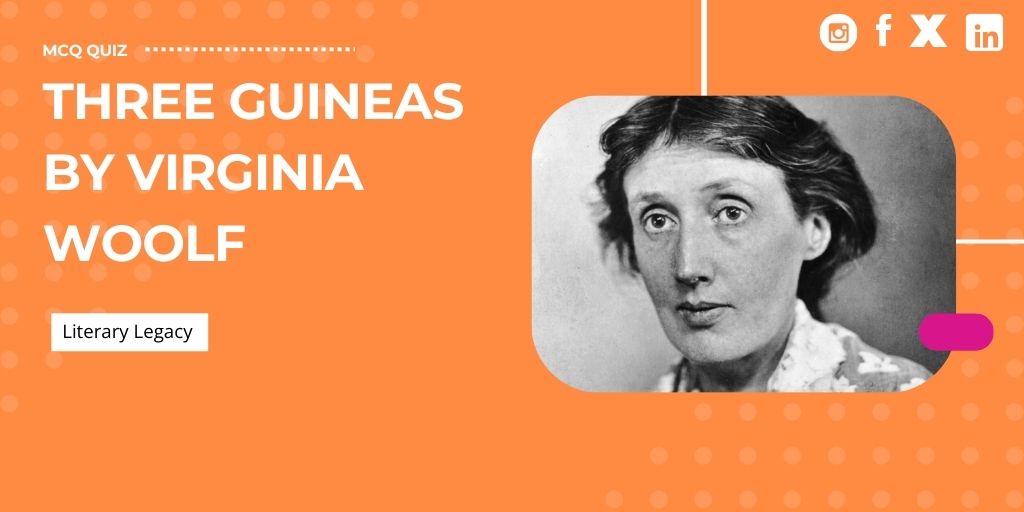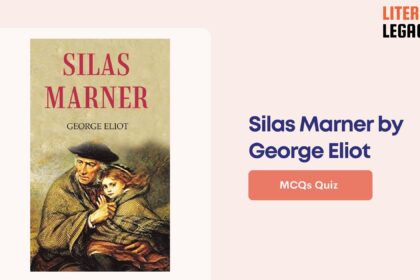1. What primarily motivates Virginia Woolf to write her letter in response to the correspondent?
Choices
A) Her commitment to pacifism and preventing war
B) Her desire to promote women’s suffrage
C) Her belief in international diplomacy
D) Her support for anti-war societies
Answer: (A)
Her commitment to pacifism and preventing war
Woolf’s pacifist stance leads her to seek ways to prevent another World War.
2. How does Virginia Woolf view the correspondent’s proposed methods to prevent war?
Choices
A) They are innovative and promising solutions
B) They are practical and realistic proposals
C) They underestimate the influence of women’s education
D) They are outdated ideas that do not address the root causes of war
Answer: (D)
They are outdated ideas that do not address the root causes of war
Woolf is disturbed by the correspondent’s ideas, feeling they ignore societal patriarchy.
3. What metaphor is represented by the ‘three guineas’ in Woolf’s essay?
Choices
A) The total amount needed to prevent war
B) The number of women who can afford university education
C) A symbol of Woolf’s personal wealth
D) A pledge for women’s education and causes
Answer: (D)
A pledge for women’s education and causes
The ‘three guineas’ symbolize her commitment to supporting educational initiatives for women.
4. What distinction does Woolf make regarding education in her letter?
Choices
A) The benefits of overseas education for both genders
B) The need for vocational training in addition to university education
C) The equal importance of public and university education
D) The lack of access to education for women compared to men
Answer: (D)
The lack of access to education for women compared to men
Woolf highlights the disparities in education funding and access between men and women.
5. What is Woolf’s stance on receiving conditional donations for women’s education?
Choices
A) Conditional donations should be accepted to ensure funding
B) They reinforce the existing structure of patriarchy
C) Such donations are necessary for institutional growth
D) They provide an opportunity for women to influence their curricula
Answer: (B)
They reinforce the existing structure of patriarchy
Woolf argues that conditional donations will perpetuate institutional patriarchy.
6. What aspect of ‘the professions’ does Woolf primarily criticize?
Choices
A) The lack of creativity in job designations
B) The requirements for a university education
C) The exclusion of women from high-level positions
D) The limited opportunities available for men
Answer: (C)
The exclusion of women from high-level positions
Woolf critiques how women are systematically excluded from professions requiring university education.
7. What tone does Woolf generally employ in her letter?
Choices
A) Solemn and serious
B) Sardonic and facetious
C) Formal and academic
D) Optimistic and encouraging
Answer: (B)
Sardonic and facetious
Woolf often uses a sardonic and facetious tone to express her arguments.
8. What primary function do the guineas serve in Woolf’s essay?
Choices
A) They are a financial burden on society.
B) They symbolize Woolf’s support for various causes.
C) They indicate the economic value of donations.
D) They represent women’s financial independence.
Answer: (B)
They symbolize Woolf’s support for various causes.
The guineas are used as a symbolic representation of Woolf’s support for causes she evaluates.
9. Why does Woolf choose to address her ideas in the form of a letter?
Choices
A) To maintain a personal touch while discussing social issues.
B) To create a formal public address to inspire change.
C) To minimize the impact of her ideas on society.
D) To distance herself from the topics of war and inequality.
Answer: (A)
To maintain a personal touch while discussing social issues.
Woolf’s letter format allows her to focus on a specific audience while addressing broader societal issues.
10. What does Woolf imply about women’s financial contributions to social causes?
Choices
A) They are more influential than men’s contributions.
B) They ensure equal representation in decision-making.
C) They are typically accompanied by significant demands.
D) They are often limited and carry less weight than men’s donations.
Answer: (D)
They are often limited and carry less weight than men’s donations.
Woolf argues that women’s capacity to contribute financially is limited, affecting their influence in shaping society.
11. What does Woolf’s frustration about her inability to respond signify in her essay?
Choices
A) Her indifference to the political climate.
B) Her desire to simplify her message to the unnamed man.
C) Her apathy towards male perspectives on war.
D) A reflection of the overwhelming nature of societal inequality.
Answer: (D)
A reflection of the overwhelming nature of societal inequality.
Woolf’s frustration illustrates her struggle with the complexities of addressing societal issues, highlighting her despair.
12. How does Woolf view the relationship between war and societal inequality?
Choices
A) War serves as a means to achieve equality.
B) Societal inequality can be ignored in times of war.
C) They are unrelated issues that require separate solutions.
D) War is a direct result of an unequal society.
Answer: (D)
War is a direct result of an unequal society.
Woolf argues that war perpetuates and arises from the inequalities within society, particularly gender-based.
13. What does Woolf equate the fight for equal rights with?
Choices
A) The struggle for women’s education
B) The fight against fascism
C) Campaigns for anti-war letters
D) Efforts to reduce poverty
Answer: (B)
The fight against fascism
Woolf draws a direct parallel between the fight for women’s rights and the fight against fascism.
14. What condition does Woolf set for giving her second guinea to the society?
Choices
A) The society must pledge to donate to anti-war causes.
B) Women must ensure equal pay in professions.
C) The society should focus solely on women’s education.
D) Members must prevent future wars.
Answer: (D)
Members must prevent future wars.
Woolf insists that her support comes with the expectation that the society works towards preventing war.
15. How does Woolf view women who are no longer victims of the patriarchal system?
Choices
A) As potential leaders in society
B) As champions of the capitalist system
C) As equals to men in professions
D) As advocates for women’s rights only
Answer: (B)
As champions of the capitalist system
Woolf warns that these women must not become champions of the oppressive system they once fought against.
16. What is Woolf’s stance regarding women’s education compared to men’s?
Choices
A) Both genders receive similar education.
B) Women’s access is often unequal.
C) Men’s education is less emphasized.
D) Women’s colleges are generally superior.
Answer: (B)
Women’s access is often unequal.
Woolf highlights that women’s education is often limited compared to the access and resources available to men.
17. What does Woolf suggest is necessary to prevent wars?
Choices
A) Joining existing organizations.
B) Writing powerful protest letters.
C) Erasing social inequality.
D) Increasing military presence.
Answer: (C)
Erasing social inequality.
Woolf believes that addressing social inequality is fundamental in preventing future wars.
18. What consequence does Woolf mention regarding donations to women’s colleges?
Choices
A) They result in higher salaries for graduates.
B) They allow greater access for men.
C) They create an obligation to the donor.
D) They enhance the quality of education.
Answer: (C)
They create an obligation to the donor.
Woolf warns that accepting donations can lead to conditions that may compromise the institution’s integrity.
19. What metaphor does Woolf use to illustrate her commitment to eradicating inequality?
Choices
A) A bridge between social classes
B) A ladder to success
C) Three guineas
D) A chain of oppression
Answer: (C)
Three guineas
The metaphor of three guineas represents Woolf’s pledge to use her resources to support equality efforts.
20. What does Woolf believe about men’s perspectives on war?
Choices
A) Men’s views are less important than women’s.
B) Men see war as a necessary evil.
C) Men are more motivated by patriotism than women.
D) Men do not influence war decisions.
Answer: (C)
Men are more motivated by patriotism than women.
Woolf argues that men’s inclination towards war is driven by their understanding of patriotism.
21. What does Woolf propose about the formation of women’s institutions?
Choices
A) They should mirror existing institutions.
B) They should avoid involvement in politics.
C) They should create better job opportunities.
D) They should focus solely on military training.
Answer: (C)
They should create better job opportunities.
Woolf advocates for women to form their own institutions to improve their access to professional opportunities.
22. What does Woolf argue is necessary to effectively combat war?
Choices
A) Encouraging women to accept limited roles
B) Increasing military funding for women’s programs
C) Promoting male-centric institutions
D) Dismantling the patriarchal society
Answer: (D)
Dismantling the patriarchal society
Woolf states that stopping war is not possible without first addressing the issues of patriarchy.
23. How does Woolf describe the relationship between patriarchy and economic inequality?
Choices
A) Patriarchy ensures equal wages for all genders.
B) Economic inequality leads to the destruction of patriarchal norms.
C) Patriarchy allows women to earn more than men.
D) Patriarchy restricts women’s economic opportunities.
Answer: (D)
Patriarchy restricts women’s economic opportunities.
Woolf notes that women are economically disadvantaged due to the constraints imposed by a patriarchal society.
24. What does Woolf suggest about existing patriarchal institutions?
Choices
A) Women need to form their own institutions.
B) They must be supported to create equality.
C) They should be reformed from within.
D) They are already supportive of women’s rights.
Answer: (A)
Women need to form their own institutions.
Woolf calls for women to establish their own institutions rather than reinforcing patriarchal ones.
25. What is Woolf’s view on the concept of meritocracy in her society?
Choices
A) Meritocracy ensures women excel in their careers.
B) It functions perfectly and benefits everyone.
C) It is a myth used to justify inequality.
D) It only applies to men in professional roles.
Answer: (C)
It is a myth used to justify inequality.
Woolf argues that the idea of meritocracy is a falsehood that supports the patriarchal system.
26. What represents Woolf’s vision for increased economic power for women?
Choices
A) The three guineas mentioned in her book
B) An increased number of male supporters
C) The ability to run for office
D) Participation in armed forces
Answer: (A)
The three guineas mentioned in her book
The three guineas symbolize the economic strength necessary for women to challenge patriarchy.
27. What does Woolf believe contributes to men’s protection of their professional advantages?
Choices
A) A desire to promote equality
B) The fear of losing their positions to women
C) Economic independence of women
D) The support from educational institutions
Answer: (B)
The fear of losing their positions to women
Woolf suggests that men’s anxieties about equality lead them to safeguard their privileges.
28. Which of the following best captures Woolf’s stance on the use of women’s talents for financial gain?
Choices
A) It is necessary for women’s liberation.
B) It can lead to exploitation of women’s skills.
C) It promotes gender equality.
D) It should be encouraged in all cases.
Answer: (B)
It can lead to exploitation of women’s skills.
Woolf expresses concern that women may feel compelled to use their talents for causes they do not support.
29. Which institution does Woolf criticize for excluding women from leadership roles?
Choices
A) Educational institutions
B) The Church of England
C) Government agencies
D) Corporate entities
Answer: (B)
The Church of England
Woolf criticizes the Church of England for not allowing women to join the clergy.
30. What is the implication of Woolf’s comparison of patriarchy and fascism?
Choices
A) They both enforce social violence and inequality.
B) Patriarchy is less harmful than fascism.
C) Both are systems that promote equality.
D) Only fascism needs to be eradicated.
Answer: (A)
They both enforce social violence and inequality.
Woolf draws a parallel between patriarchy and fascism in their mutual support of inequality and oppression.
31. What economic limit does Woolf point out that women face compared to men?
Choices
A) Men have a fixed wage limit of £250.
B) Women earn equal wages as men regardless of experience.
C) Women can earn a maximum of £250, while men face no limit.
D) Women can earn more than men in certain fields.
Answer: (C)
Women can earn a maximum of £250, while men face no limit.
Woolf highlights that women’s maximum earnings are capped, contrasting sharply with men’s income potential.
32. What does Woolf suggest is a primary cause of war?
Choices
A) A lack of military power
B) Cultural differences
C) Nationalism
D) Unequal society
Answer: (D)
Unequal society
Woolf argues that war is a product of an unequal society, and cannot be prevented until equality is achieved.
33. Which aspect of society does Woolf highlight as being interlinked with war?
Choices
A) Religious conflict
B) Gender inequality
C) Technological advancement
D) Economic stability
Answer: (B)
Gender inequality
Woolf presents war, inequality, patriarchy, and women’s rights as inextricably linked, arguing for women’s equal role in society.
34. How does Woolf regard the focus on war in pacifist movements?
Choices
A) As the primary solution to conflict
B) As an effective means of promoting peace
C) As a distraction from root causes
D) As unnecessary and misguided
Answer: (C)
As a distraction from root causes
Woolf suggests that pacifists should stop focusing solely on war and examine the underlying causes of conflict.
35. In the context of Woolf’s arguments, what do the ‘three guineas’ symbolize?
Choices
A) Support for military efforts
B) Cultural resistance to change
C) Wealth redistribution
D) Archaic systems hindering progress
Answer: (D)
Archaic systems hindering progress
The guineas represent an outdated system that, although no longer in circulation, is still referenced and used in efforts to promote progressive causes.
36. What primarily limits Woolf’s analysis of class inequality?
Choices
A) Empathy for working-class women
B) A lack of historical context
C) The focus on middle-class professionals
D) Gender-related biases in literature
Answer: (C)
The focus on middle-class professionals
Woolf’s critique mainly focuses on the experiences of women related to educated men, thereby limiting her analysis of class-based inequality.
37. What does Woolf imply is necessary for a meaningful change in preventing war?
Choices
A) Strengthening national borders
B) Establishing peace treaties
C) Increased political representation for women
D) Reduction of military spending
Answer: (C)
Increased political representation for women
Woolf highlights the need for women to have a greater role in politics and society as a means to address inequality and prevent war.
38. What common misconception does Woolf address regarding the nature of war?
Choices
A) It can be resolved through diplomacy
B) It is an inevitable consequence of nationalism
C) It primarily affects men
D) It is only a military phenomenon
Answer: (D)
It is only a military phenomenon
Woolf warns against viewing war in isolation as an illness, emphasizing that it is a symptom of deeper societal issues.
39. Which of the following best captures Woolf’s view on the impact of World War I on her contemporaries?
Choices
A) It created a longing for past military glories
B) It led to an urgent need for social change
C) It inspired a complete rejection of pacifism
D) It was seen as a necessary evil
Answer: (B)
It led to an urgent need for social change
Woolf and her contemporaries viewed World War I as a pivotal event that underlined the necessity for social and gender equality.
40. How does Woolf characterize the patriarchy in relation to war?
Choices
A) As a safeguard against conflict
B) As intertwined with the social fabric
C) As an independent issue
D) As a weakening force in society
Answer: (B)
As intertwined with the social fabric
Woolf presents the patriarchy as deeply connected to war, emphasizing that dismantling it is crucial for peace.



